Employee Scheduling Techniques: Reduce Conflicts & Maximize Coverage

In the intricate dance of business operations, effective employee scheduling serves as the rhythm that harmonizes productivity and efficiency. From optimizing workforce utilization to fostering work-life balance, mastering employee scheduling techniques and staff scheduling tips is crucial for organizational success. If you’re looking for new employee scheduling ideas and an answer to the question “How to improve the scheduling process?”, you’ve come to the right place!
9 Best Employee Scheduling Techniques & Tips
Whether you’re a small business owner or a seasoned professional, mastering these proven employee scheduling tips and tricks will empower you to create efficient schedules that meet both organizational needs and employee preferences. Join us as we explore key strategies and the best way to schedule employees to help you manage your team effectively and achieve success in workforce management.
🔧 Use scheduling software
Scheduling software revolutionizes the way businesses manage their workforce by automating the complex task of creating, managing, and communicating schedules. With features designed to streamline scheduling processes and enhance communication, the best employee scheduling software offers a comprehensive solution for businesses of all sizes.
Benefits of scheduling software
- Time savings: By automating schedule creation and management tasks, scheduling software saves managers and HR professionals valuable time that can be allocated to more strategic initiatives.
- Increased accuracy: Scheduling software reduces the risk of human errors associated with manual scheduling processes, ensuring that schedules are accurate and compliant with labor laws and regulations.
- Enhanced communication: Scheduling software facilitates seamless communication between managers and employees by providing a centralized platform for accessing schedules, requesting time off, and communicating shift changes.
- Improved employee satisfaction: With features such as shift swapping and self-scheduling, scheduling software empowers employees to have more control over their schedules, leading to higher levels of job satisfaction and engagement.
- Real-time updates: Modern scheduling software offers real-time schedule updates, allowing managers to make adjustments on the fly and ensuring that employees have access to the most up-to-date information.
- Compliance management: Scheduling software helps businesses stay compliant with labor laws and regulations by automatically tracking employee hours, breaks, and overtime eligibility.
- Data-driven insights: Many scheduling software solutions offer analytics and reporting features that provide valuable insights into workforce trends, scheduling inefficiencies, and labor costs, enabling businesses to make data-driven decisions.
Shifts by Everhour: The ultimate scheduling solution
Among the myriad scheduling software options available, Shifts by Everhour stands out as a top choice for businesses seeking a user-friendly, feature-rich solution. With its intuitive interface and powerful feature set, Shifts by Everhour offers everything businesses need to streamline their scheduling processes and optimize workforce management.
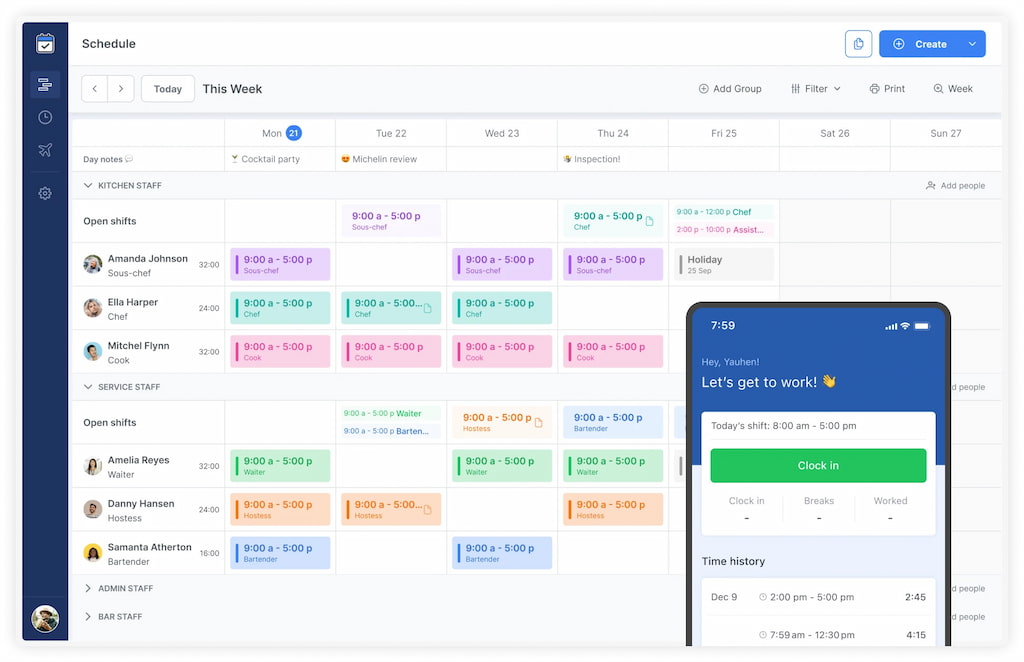
Key features of Shifts by Everhour
- Shift scheduling: Simplify the process of creating and managing schedules for your team, ensuring that the right people are in the right place at the right time.
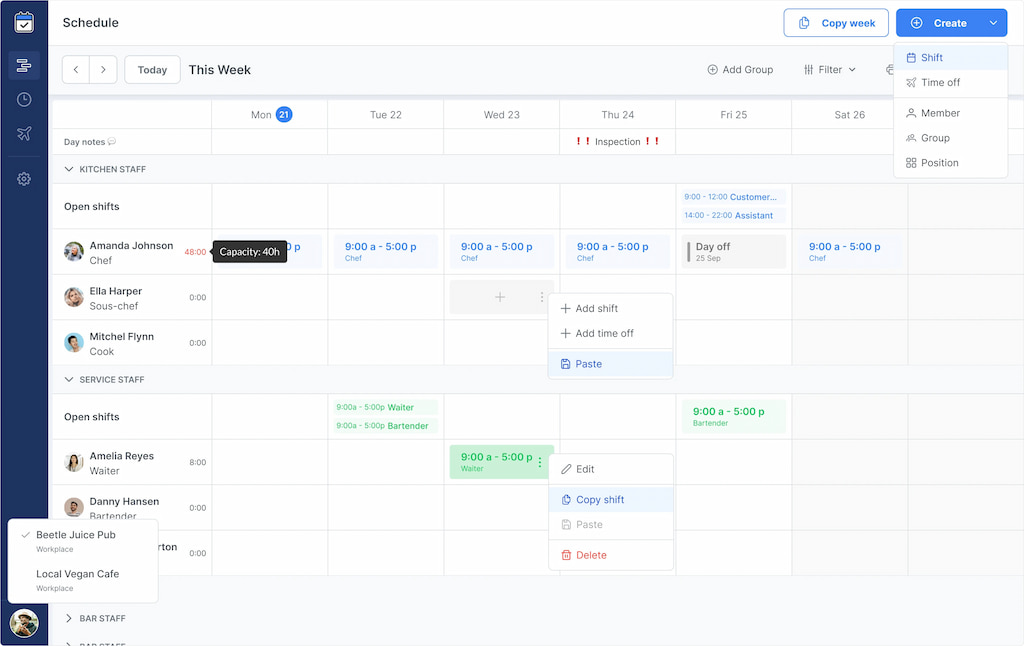
- Employee availability tracking: Easily track employee availability and preferences to accommodate individual scheduling needs.
- Mobile clock-in and clock-out: Enable employees to view schedules and track hours from their mobile devices, providing flexibility for on-the-go time management.
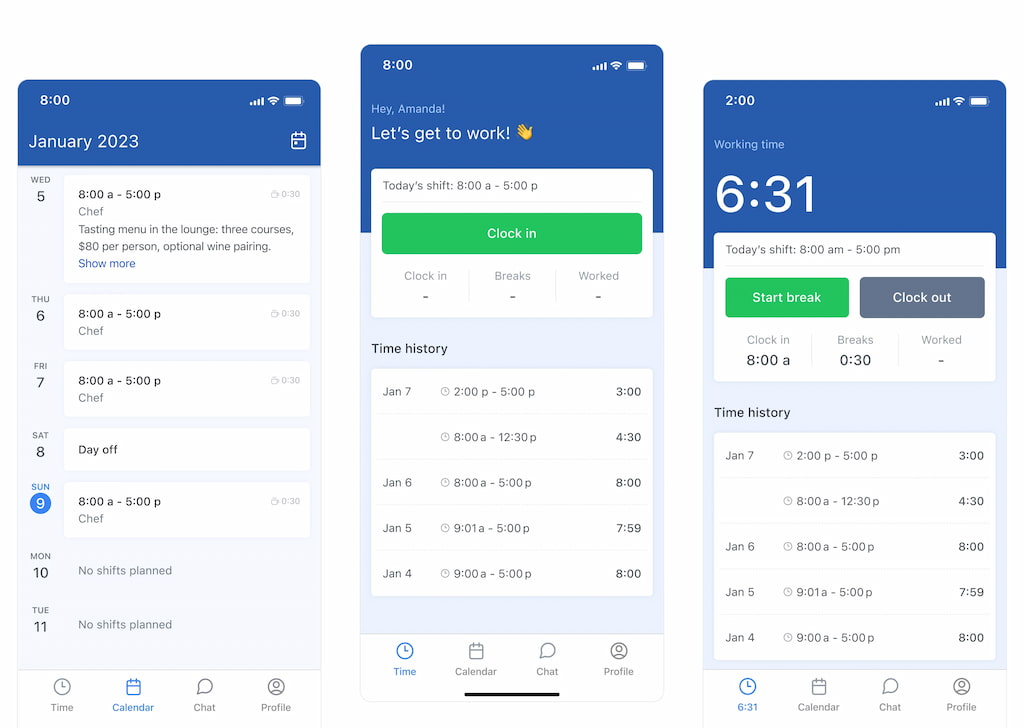
- Shift templates: Create reusable shift templates for common scheduling scenarios, saving time and ensuring consistency.
- Attendance and payroll: Centralize timesheets for easy access and management, allowing administrators to view and adjust attendance data as needed and streamline the payroll process with comprehensive tracking features.
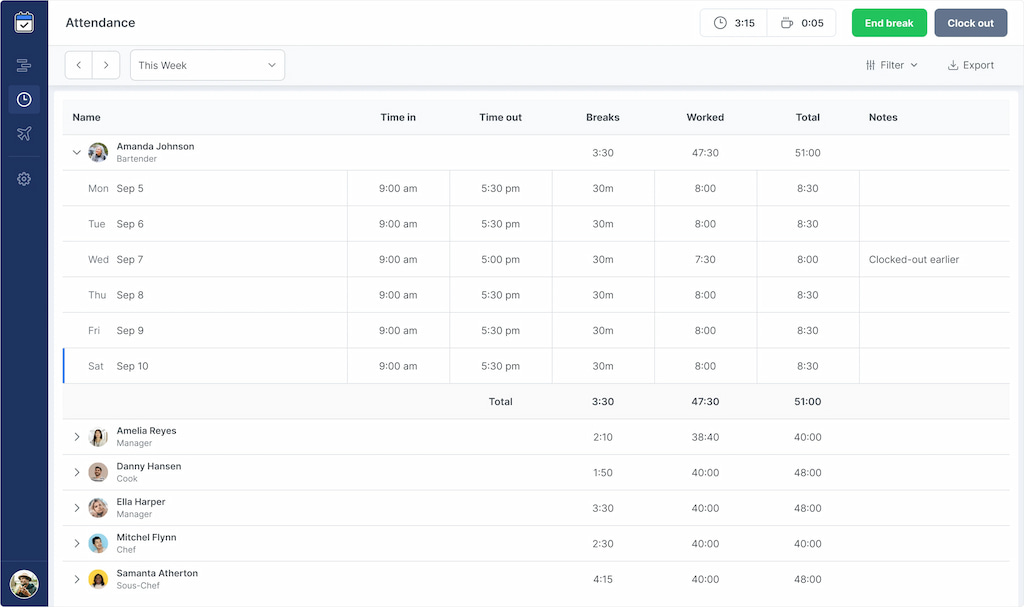
- Real-time schedule updates: Instantly update schedules and communicate changes to employees in real-time, minimizing confusion and ensuring transparency.
- Compliance monitoring: Automatically track hours worked, breaks taken, and overtime eligibility to ensure compliance with labor laws and regulations.
How to schedule employees effectively with Shifts by Everhour
- Customization: Tailor Shifts by Everhour to your business’s unique scheduling needs by configuring shift templates, employee availability settings, and communication preferences.
- Training and support: Provide comprehensive training and ongoing support to managers and employees to ensure they can fully leverage the features and functionalities of Shifts by Everhour.
- Feedback and iteration: Solicit feedback from users and regularly evaluate the effectiveness of Shifts by Everhour in meeting your scheduling goals. Make adjustments and iterate on your scheduling processes as needed to optimize efficiency and employee satisfaction.
By embracing scheduling software like Shifts by Everhour, businesses can streamline their scheduling processes, improve communication, and empower employees to take control of their schedules, ultimately leading to a more efficient and productive workforce.
🔮 Utilize forecasting tools
Utilizing forecasting tools involves leveraging technology and data analysis to predict future staffing needs based on historical data, trends, and business projections. It begins with gathering and analyzing historical data related to employee scheduling, such as sales data, foot traffic, or customer demand. This data provides insights into past staffing patterns and seasonal fluctuations.
Once historical data is collected, the next step is to identify recurring patterns, trends, and seasonality. This involves analyzing the data to understand trends related to the day of the week, time of day, or specific events or promotions that impact staffing requirements. Additionally, business projections, such as upcoming events or marketing campaigns, are considered to predict future staffing needs.

Forecasting models or algorithms are then used to predict future staffing requirements based on historical data and business projections. These models may include time series analysis, regression analysis, or machine learning algorithms to forecast demand accurately. Seasonal variations and trends are factored into the models to ensure accuracy in predicting staffing needs.
Regular review and refinement of forecasting models are essential to ensure accuracy and reliability over time. This involves updating the models with new data and adjusting them based on actual performance and feedback. Integration with web-based staff scheduling software automates the staff scheduling process based on forecasted demand, streamlining scheduling processes and ensuring that staffing levels align with predicted demand.
🤸♀️ Implement flexible scheduling
Implementing flexible scheduling involves offering employees options and autonomy regarding their work hours and location. It encompasses various arrangements, such as part-time schedules, telecommuting, compressed workweeks, and flexible hours.
- To make flexible scheduling work effectively, start by surveying employees to understand their preferences and needs. This can help identify the most desired flexibility options and tailor scheduling arrangements accordingly.
- Establish clear guidelines and policies outlining the parameters and expectations for flexible scheduling arrangements. These guidelines should address issues such as core hours, availability, communication expectations, and performance metrics.
- Ensure that flexible scheduling arrangements align with business objectives and operational requirements. For example, assess the impact of flexible scheduling on customer service hours, team collaboration, and workflow efficiency.
- Implement communication channels and tools to facilitate coordination and collaboration among team members, especially when employees have varying schedules or telecommute. This may include using messaging platforms, video conferencing tools, or project management software to keep everyone connected and informed.
- Regularly evaluate the effectiveness of flexible scheduling arrangements and solicit feedback from employees to identify areas for improvement. Adjust policies and procedures as needed to optimize the balance between employee flexibility and business needs.
Overall, implementing flexible scheduling requires a thoughtful approach that balances employee preferences with organizational requirements to create a work environment that fosters productivity, satisfaction, and work-life balance.
😎 Prioritize employee preferences
Prioritizing employee preferences involves taking into account individual scheduling preferences, availability, and constraints when creating work schedules. This approach recognizes the significance of work-life balance and employee satisfaction in fostering a positive and productive work environment. To make prioritizing employee preferences work effectively:
- Regularly collect feedback: Establish mechanisms for regularly gathering feedback from employees regarding their scheduling preferences and availability. This can be done through surveys, one-on-one meetings, or suggestion boxes. Encourage open communication and actively listen to employees’ concerns and preferences.
- Utilize scheduling software: We’ve already talked about how scheduling software can immensely help with shifts, but it’s worth repeating: invest in scheduling software that allows employees to input their preferred shifts or indicate their availability. This type of software streamlines the scheduling process by providing managers with real-time visibility into employees’ scheduling preferences. It also allows for better coordination and reduces the likelihood of scheduling conflicts.
- Consider individual needs: Take into consideration each employee’s unique needs, such as childcare responsibilities, transportation constraints, or personal commitments. You demonstrate empathy and respect for your employees’ work-life balance by accommodating individual preferences and constraints.
- Flexibility and adaptability: Remain flexible and adaptable when creating schedules, especially in response to changing circumstances or unexpected events. Be willing to make adjustments to accommodate employees’ needs while still ensuring operational requirements are met.
By prioritizing employee preferences in scheduling, organizations can foster a supportive and inclusive work environment that promotes employee engagement, satisfaction, and retention.
🏋️ Cross-train employees
One of the most crucial scheduling tips for managers is to cross-train your employees. It is about empowering them with the skills and knowledge to handle various roles or tasks within the company. To effectively implement cross-training:
- Identify critical roles: Pinpoint the key positions or tasks crucial for business continuity. This helps in determining which areas would benefit most from cross-training.
- Customize training programs: Tailor training programs to suit the unique requirements of each role. This might involve a mix of formal training sessions, hands-on experience, and mentorship.
- Promote collaboration: Cultivate a collaborative environment where employees feel comfortable sharing their expertise. This fosters a culture of learning and facilitates cross-training initiatives.
- Offer practice opportunities: Provide ample opportunities for employees to put their new skills into practice. This could include shadowing experienced colleagues, participating in simulations, or taking on temporary assignments in different departments.
- Provide support and feedback: Offer ongoing support and constructive feedback to employees throughout the cross-training process. Encourage open communication and address any challenges they may encounter.
- Evaluate effectiveness: Regularly assess the impact of cross-training efforts to ensure they align with organizational goals. Solicit feedback from employees and managers to identify areas for improvement.
☕ Schedule breaks strategically
Strategically scheduling breaks is paramount for maintaining employee well-being, preventing burnout, and optimizing productivity. Breaks provide employees with crucial opportunities to recharge, refocus, and maintain mental and physical health throughout the workday.
Importance of breaks
- Preventing burnout: According to a study by the World Health Organization (WHO), prolonged periods of work without breaks increase the risk of burnout and stress-related illnesses among employees.
- Enhancing productivity: Research conducted by the University of Illinois found that brief breaks throughout the workday improve focus, creativity, and cognitive function, leading to higher overall productivity.
- Improving decision-making: Studies published in the Journal of Applied Psychology indicate that regular breaks improve decision-making abilities and reduce the likelihood of errors and accidents in the workplace.
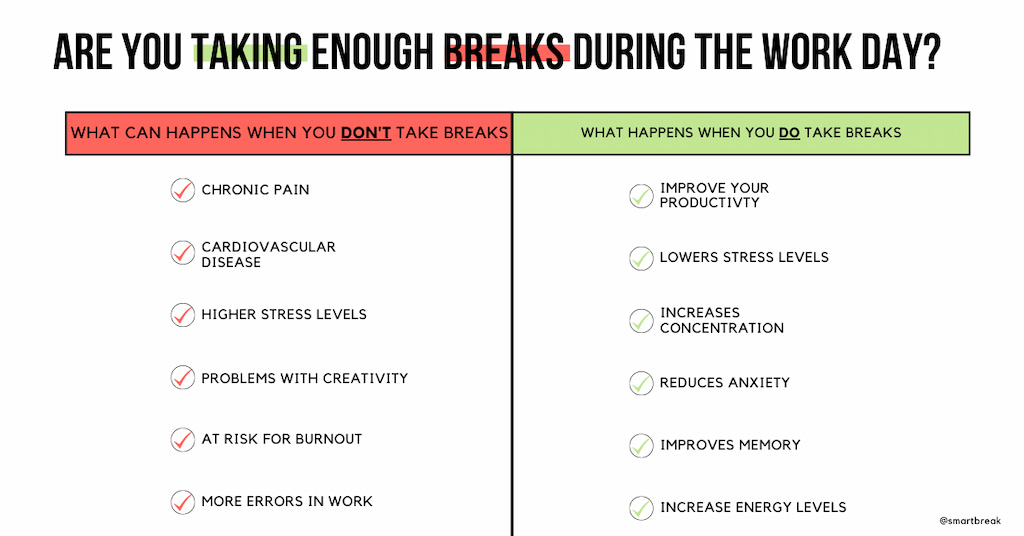
Implementing strategic break scheduling
- Understanding employee needs: Recognize that employees have varying energy levels and attention spans throughout the day. By scheduling breaks strategically, employers can align break times with periods of decreased productivity or concentration.
- Encouraging movement and relaxation: Breaks provide opportunities for employees to engage in physical activity, stretch, or practice relaxation techniques. Brief breaks involving movement can alleviate physical discomfort associated with prolonged sitting and reduce musculoskeletal issues.
- Promoting mental well-being: Breaks allow employees to disconnect from work-related stressors, reducing feelings of anxiety and overwhelm. Regular breaks during the workday are associated with lower levels of perceived stress and higher job satisfaction.
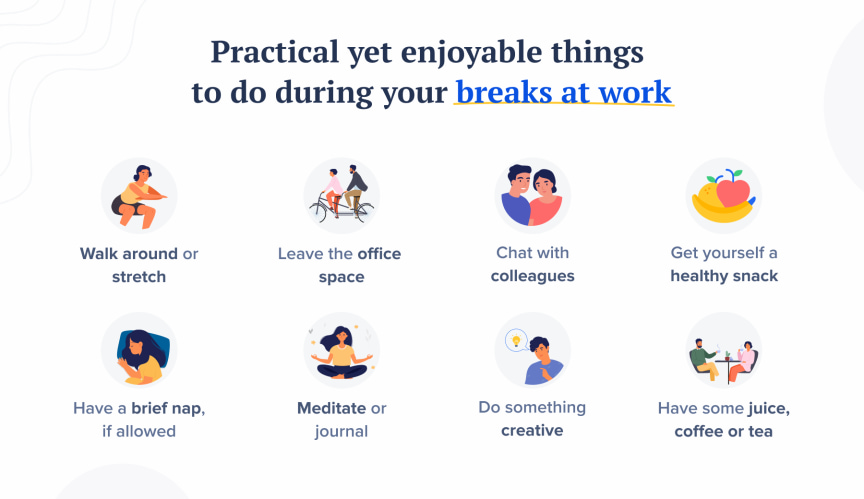
Utilizing break scheduling tools
- Automating break reminders: Implement the best scheduling software equipped with break scheduling features to automate break reminders and ensure compliance with scheduled break times.
- Tailoring break schedules: Customize break schedules to accommodate the unique needs and preferences of employees, taking into account factors such as workload, shift duration, and individual circadian rhythms.
- Encouraging break compliance: Effective scheduling of employees isn’t possible without a supportive workplace culture that encourages employees to prioritize breaks and take advantage of designated break times. Provide education and resources on the importance of breaks and the benefits of incorporating regular rest periods into the workday.
🔁 Adopt shift swapping and trading
Shift swapping and trading is a method that allows employees to exchange shifts with their coworkers to accommodate personal commitments or unexpected changes in availability. This approach provides employees with flexibility and autonomy over their schedules while ensuring that operational needs are met. To successfully implement shift swapping and trading:
- Establish clear guidelines: Define clear guidelines and policies outlining the process for shift swapping and trading. Specify how requests should be submitted, approved, and communicated to ensure transparency and fairness for all employees.
- Encourage communication: Foster a culture of open communication among employees to facilitate the exchange of shifts. Encourage employees to discuss potential swaps with their coworkers and communicate any scheduling conflicts or preferences in advance.
- Ensure fairness: Implement mechanisms to ensure fairness and equity in the shift-swapping process. Monitor the frequency of swaps to prevent any one employee from consistently trading undesirable shifts, and establish guidelines for resolving conflicts or disputes that may arise.
- Provide training and support: Offer training and support to employees on how to use the shift-swapping system effectively. Ensure that employees understand the guidelines and procedures for requesting and approving swaps, and provide assistance as needed.
💻 Monitor and adjust schedules
Monitoring and adjusting schedules is a crucial aspect of workforce management that involves continuously tracking schedule adherence, employee performance, and operational metrics to ensure efficiency and productivity. By regularly reviewing and adjusting schedules, businesses can optimize workforce utilization, improve employee satisfaction, and enhance overall operational performance. Monitoring and adjusting schedules encompasses several key activities:
- Schedule adherence: Tracking employee adherence to assigned schedules to ensure that they are arriving on time, taking breaks as scheduled, and adhering to assigned tasks and responsibilities.
- Operational metrics: Monitoring operational metrics such as workload distribution, resource utilization, and customer satisfaction to identify inefficiencies and opportunities for optimization.
- Regular review: Schedule regular reviews of schedule adherence, employee performance, and operational metrics to identify trends, patterns, and areas for improvement.
- Data-driven decisions: Use data and analytics to make informed decisions about scheduling adjustments. Utilize workforce management software to collect and analyze data on schedule adherence, employee performance, and operational metrics.
- Employee feedback: Solicit feedback from employees about their schedules, workload, and job satisfaction. Use this feedback to identify areas for improvement and make adjustments to schedules as needed.
- Continuous improvement: Treat schedule monitoring and adjustment as an ongoing process of continuous improvement. Regularly evaluate the effectiveness of scheduling practices and make adjustments as needed to optimize efficiency and productivity.
🗣️ Communicate effectively
Effective communication is essential in workforce management to ensure clarity, collaboration, and alignment among team members and across departments. By fostering open and transparent communication channels, businesses can improve productivity, resolve conflicts, and enhance overall organizational performance.

Key aspects of effective communication
- Clear expectations: Communicate clear expectations regarding roles, responsibilities, and objectives to ensure that employees understand what is expected of them. Provide detailed job descriptions, performance goals, and project guidelines to minimize confusion and ambiguity.
- Open communication channels: Establish open communication channels, such as team meetings, one-on-one discussions, and digital platforms, to encourage regular interaction and feedback exchange. Encourage employees to voice their concerns, ideas, and suggestions openly and without fear of reprisal.
- Active listening: Practice active listening by attentively listening to employees’ concerns, questions, and feedback. Demonstrate empathy and understanding, and provide constructive responses and solutions to address their needs and issues effectively.
- Timely and transparent updates: Keep employees informed about important updates, changes, and developments within the organization in a timely and transparent manner. Communicate key information through various channels, such as email newsletters, team announcements, and intranet platforms.
- Conflict resolution: Develop effective conflict resolution strategies to address conflicts and disagreements promptly and constructively. Encourage open dialogue, mediation, and compromise to find mutually acceptable solutions and maintain positive working relationships.
- Training and development: Provide communication training and development opportunities to employees to enhance their communication skills, including active listening, conflict resolution, and interpersonal communication. Offer workshops, seminars, and online courses to help employees improve their communication abilities.
Frequently Asked Questions (FAQs)
1. What are employee scheduling techniques, and why are they important for businesses?
Employee scheduling techniques are methods used by businesses to create and manage work schedules for their workforce. These techniques are essential for ensuring efficient operations, optimal resource utilization, and employee satisfaction.
2. How can businesses prioritize employee preferences when creating schedules?
Prioritizing employee preferences involves considering individual preferences, availability, and constraints when creating schedules. This approach recognizes the importance of work-life balance and aims to accommodate employees’ needs while meeting business objectives.
3. What is shift swapping, and how can it benefit businesses?
Shift swapping allows employees to exchange shifts with coworkers to accommodate personal commitments or unexpected changes in availability. It fosters flexibility and ensures that shifts are adequately covered, reducing the need for last-minute schedule adjustments.
4. How can businesses effectively monitor and adjust schedules to optimize workforce management?
Continuous monitoring and adjustment of schedules involve tracking schedule adherence, employee performance, and operational metrics to identify areas for improvement and make necessary adjustments. Regular review and data-driven decisions are key to optimizing schedules.
5. What role does scheduling software play in employee scheduling techniques?
Scheduling software automates the process of creating, managing, and communicating schedules. It offers features such as shift templates, employee availability tracking, and real-time schedule updates, streamlining the scheduling process and enhancing communication.
6. How can businesses implement flexible scheduling to accommodate diverse workforce needs?
Flexible scheduling allows employees to have more control over when and where they work, including options such as part-time schedules, telecommuting, compressed workweeks, and flexible hours. Surveying employees and establishing clear guidelines are crucial for successful implementation.
7. What are some common challenges businesses face when implementing employee scheduling techniques?
Common challenges include balancing employee preferences with operational requirements, managing shift coverage during peak periods, and ensuring compliance with labor laws and regulations. Effective communication, planning, and use of technology can help overcome these challenges.
8. How can businesses ensure fair and equitable scheduling practices for all employees?
Fair and equitable scheduling practices involve considering factors such as seniority, skills, availability, and preferences when creating schedules. Establishing clear policies, providing training, and using scheduling software with built-in fairness features can promote fairness in scheduling.
9. What are some tips for optimizing break scheduling to improve employee well-being and productivity?
Strategic break scheduling involves planning regular breaks and rest periods to prevent burnout, improve productivity, and maintain employee well-being. Establishing clear policies, using scheduling software for automation, and promoting a culture of taking breaks are essential for success.
10. How can businesses effectively communicate schedules and changes to their workforce?
Effective communication of schedules and changes involves using multiple channels such as email, messaging apps, and scheduling software. Providing advanced notice, seeking feedback, and being transparent about scheduling practices can help foster a positive work environment.
Employee Scheduling Techniques: Conclusion
In conclusion, mastering effective employee scheduling techniques and best practices is vital for businesses aiming to optimize operations and ensure employee satisfaction. By delving into methods like prioritizing employee preferences, embracing flexibility, and utilizing advanced scheduling software, organizations can craft schedules that cater to both operational needs and individual employee requirements.
Among the plethora of scheduling solutions available, Shifts by Everhour stands out as the premier choice.
With its intuitive interface, robust features, and seamless integration capabilities, Shifts by Everhour empowers businesses to optimize their scheduling practices and achieve unparalleled efficiency. Say goodbye to scheduling headaches and hello to effortless scheduling with Shifts by Everhour.
If you’re looking for a seamless way to improve shift planning, Shifts by Everhour is the perfect solution. With features like real-time monitoring, easy scheduling, and mobile accessibility, managing your workforce has never been simpler.
